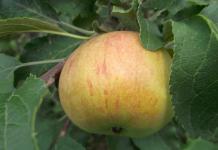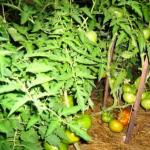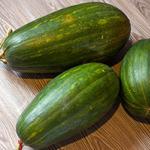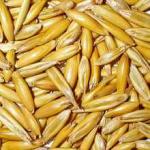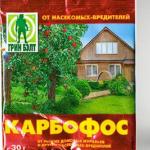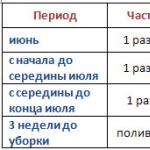With the onset of summer, we look forward to harvesting tomatoes, monitoring their condition: flowering and watering. In general, it is important for every gardener that every leaf of this crop is healthy throughout the season. Every year, gardeners hope that this year's tomatoes will be tastier than last year. Therefore, in this article we decided to tell such gardeners about how to increase the yield of tomatoes in open ground. We will also tell you what secrets can increase the yield of this crop.
RULE 1: DO YOU NEED TO SPRAY?
In order for your tomatoes to produce a lot of fruit, it is necessary to treat the bushes with a small amount of boric acid during the flowering of the second and third flower clusters. This promotes rapid fruit set and plant growth. Also, “boron” promotes the appearance of new shoots and the fruits will become much sweeter. If you use this rule, the tomato harvest yield will increase to 20%. Solution recipe: For 1-2 spraying times you will need to dissolve 10 grams of boric acid powder in 10 liters of water.
RULE 2: “TOMATO SHOCK”
This article will allow you to learn how to increase the yield of tomatoes in open ground. And here it is worth giving the most effective advice. For tomatoes to grow better, nature itself helps you: the wind and various insects are the first helpers in pollination. But what to do if you planted tomatoes in a greenhouse and not in open ground? After all, there is no wind in the greenhouse, and insects rarely fly in. There is an exit! Experienced gardeners advise arranging a little “shake-up”. Every few days you need to shake the flower brushes, and then use rule No. 1 and spray the plants. All that remains is to water the beds and ventilate the greenhouse after about a couple of hours.
RULE 3: INVENTIVE GROUNDING
If you want to increase the yield of tomatoes planted in a greenhouse, then you need to place the beds “widthwise” - from east to west. This will allow the plants to receive proper sun “baths”. Thanks to this secret, your tomatoes will receive more morning sunlight and will not be shaded by neighboring beds at lunchtime.
RULE 4: STEEL ROOTS
All gardeners know that in order for a plant to produce a lot of large fruits, it needs a strong foundation, i.e. roots. But few people know that the root system of the tomato bush itself can be improved.
Hilling
Of course, there are some tricks here too. Plants need to be earthed up only when the roots are growing, since the roots of tomatoes grow in periods. At the beginning of the bush's germination, the root begins to grow. In order for the main “green” part of the tomatoes to begin to grow, the root stops growing and gives way to the stem. Then the roots continue to grow until flowering and fruit formation. As soon as this starts, the roots stop growing again.
An experienced summer resident will always notice when exactly it is necessary to hill up. The plants themselves will tell him about this. To begin with, hilling is necessary so that small pimples appear on the bottom of the stem. It is necessary to hill up only if the soil is wet. The time for the second hilling occurs when the stem changes color: from green to bluish. If you follow these rules, then soon the root system of your bushes will help the plant produce a large harvest.

Mulching
Avid gardeners have long known the benefits of mulching. After all, under a layer of mulch the soil is preserved, weeds do not grow and there is a sufficient amount of moisture. Proper mulching will bring a lot of benefits and will help increase productivity by as much as 30%. What is the best way to mulch tomatoes? Excellent mulches for tomatoes include compost, straw, hay, newsprint and fallen leaves. For each plant, the most important thing is to choose the mulch that suits it.
RULE 5: GOOD SOIL
In order to increase the yield of tomatoes using traditional methods, you need to know how to do it correctly. And if you don’t know how to do this, then you should read our publication to the end.
So, a good summer resident knows that tomatoes will grow well on their tops. This must be taken care of in advance. With the onset of autumn and the preparation of the land for winter, it is necessary to collect all the old tomato tops, chop them up and add them to the soil where your future tomatoes will be located. The bravest summer residents tell the secret that if you want to increase the yield by 50%, then when planting seedlings under the root system you need to put one small fresh fish at a time.
RULE 6: STEPSONING
Few people know what it is? So, pinching is the removal of unnecessary shoots. To ensure that the growth forces of the plant do not just go away, but are beneficial for the harvest, it is necessary to cut off excess greenery. This will prevent the nutrients from working for future use. But there are some secrets here too. To prevent the stepchildren from appearing again, it is necessary to remove them not completely, leaving a shoot up to the stem about 1 cm in size. This process is carried out in open ground beds once a season, but some do this several times (if new stepchildren appear).
RULE 7: FOLIAGE TRIM
In order for the leaves to give their strength to the flowers and fruits, it is necessary to trim the foliage during the fruiting period. It is also worth trimming the lower leaves. Usually these leaves coming into contact with the ground can cause infection. Garden regulars suggest trimming 1-3 of the lowest leaves every week until the first flowering. It is recommended to start pruning foliage in mid-June. Trimming the foliage will help the plant “breathe” better and relieve stress on the stem. The most important rule for pruning foliage is that pruning must be done before fruits have formed in the cluster, and all the leaves on top must be “in place.” In order for the cutting mark to “heal” before infection occurs, the removal of leaves must be done in the morning in dry, warm weather.

RULE 8: ADDITIONAL FERTILIZER
To get an early harvest, tomatoes need more than just root feeding. The most common spraying of the green mass of the plant will give the tomatoes more strength and protect them from unexpected infections. The most favorable time for foliar feeding is in the evenings in calm weather. Feeding recipe:
- urea (1 tsp per 10 liters of water);
- potassium nitrate or potassium monophosphate (1 tsp per 10 liters of water);
- calcium nitrate (1 tsp per 10 liters of water);
- 1 l. serum and 20 drops of iodine per 10 liters. water.
Such simple manipulations will allow you to increase the yield and taste of tomatoes, since such fertilizers bring many nutrients to future fruits.
RULE 9: “SNACK” FOR FRUIT
Many novice gardeners begin fertilizing only when the tomato bush begins to bear fruit. But it's not right! Tomatoes need fertilizing and additional nutrition only during the growth period of the plant itself. During the fruiting period we can offer the following:
Recipe 1: Ash
To give tomatoes more sweetness, you can add ash to the soil. It must be scattered under the bushes at a rate of 3-4 tablespoons per 1 sq.m.
Recipe 2: Nutritious “drink”
Fill 2 liter jars of ash with 5 liters of boiling water, after cooling, bring the volume to 10 liters + 10 g of boric acid powder + 10 ml of iodine (bottle). It is recommended to infuse the solution for 1 day. Dilute the resulting infusion 10 times. The feeding rate is 1 liter for each bush.
Recipe 3: Yeast
100 grams of live yeast and half a glass of sugar must be placed in a three-liter jar. Then add warm water and let it ferment. Shake occasionally during the fermentation process. This “cocktail” should be used as follows: for 10 liters. water - 1 glass of mash, but not more than 1 liter for one bush.

Finally
Good luck and more harvest!
With the onset of summer and hot weather, summer residents are thinking about how to grow tomatoes; growing tomatoes in open ground, they face some problems. We'll help you sort them out.
- Tomatoes are watered for the first time 2-3 weeks after planting in open ground;
- in the first half of summer, plants are watered rarely, but abundantly: 1-2 times every 10 days, while 3-4 liters of water are consumed per plant;
- during the formation of ovaries, the watering rate is increased by 2 times and the plants are watered every 2-3 days (do this in 2-3 doses so that the soil is better saturated with moisture);
- When the tomatoes begin to ripen, stop watering.
If the temperature in summer is higher than usual, then you will have to water the plants more often (every 2-4 days). Alas, in the midst of a drought, simply pouring twice the volume of water on the tomatoes once a week will not work - after the soil has become very dry, you cannot immediately water heavily - the fruits may fall off, crack, or develop blossom end rot. The watering rate in this case is 0.8-1 liters per plant at a time.
How to feed tomatoes outdoors in summer
 Timely summer feeding of tomatoes is one of the most important guarantees of an excellent harvest, so this procedure cannot be neglected. How and what to feed tomatoes in open ground?
Timely summer feeding of tomatoes is one of the most important guarantees of an excellent harvest, so this procedure cannot be neglected. How and what to feed tomatoes in open ground?
Mineral fertilizers are applied under the roots in liquid form after watering. Do this in the morning or evening in dry weather. Foliar feeding of tomatoes (by leaves) is best done in the evening (especially if the summer is hot), when the nutrient solution applied to the leaves dries out slowly, and morning dew promotes better absorption. Such fertilizing is often carried out in conjunction with the treatment of tomatoes against diseases or pests.
The first time fertilizer is applied 2-3 weeks after planting the seedlings in the ground, during the formation of ovaries on the first inflorescence (weakened plants can be fed a week earlier). This could be, for example, a solution of chicken manure (0.5 liters of chicken manure per bucket of water). This fertilizing should include superphosphate (1 tbsp per 10 liters of water) and potassium sulfate (1 tsp per 10 liters of water).
The second, and, if necessary, third feeding is carried out during massive growth and ripening of fruits at the rate of 15-20 g of ammonium nitrate and 20-25 g of potassium sulfate per 1 sq.m.
Your tomatoes will also be grateful for root feeding with nettle infusion - nettles without roots are placed in a barrel up to half the volume, filled with water and covered with film. After 7-10 days the fertilizer is ready for use.
With the onset of fruiting, dry ash can be poured under each tomato bush after watering at the rate of 3-4 tbsp. per 1 sq.m. It can be applied throughout the entire fruiting period every 10-14 days.
Foliar feeding is also useful. To stimulate the appearance of ovaries during the flowering period, once every 10 days, tomatoes are sprayed with boric acid (10 g diluted in 10 liters of hot water, the solution is cooled before use). And to speed up the ripening of fruits, immediately after planting seedlings and during the formation of buds, tomato bushes are sprayed with Ovary or Tomaton (stimulants are not recommended to be used more than twice a season).
How to spray tomatoes against diseases and pests in summer

In order to protect plants from diseases and pests, as well as to increase the emerging harvest, one should not forget about preventive measures - in summer, young tomatoes in open ground especially need protection from diseases and pests.
From mid-June, start carrying out preventive sprays on the leaves against late blight - the most common and dangerous disease of tomatoes. For this purpose, various antifungal agents are used - furatsilin, Quadris, etc. according to the instructions.
If you grow late-ripening tomatoes, you can use serious fungicides (Profit Gold, Hom, Ordan), but if the harvest is about to ripen, it is better to use biological products (for example, Fitosporin).
If the first signs of disease appear on tomatoes, use fungicides, for example, Penncozeb.
Spraying plants with insecticides (Fitoverm, Decis, Fosbecid, Aktara and so on.). When using any medications, strictly follow the instructions and take precautions.
In July, we will have to switch from chemical tomato protection products to biological ones - the plants begin to actively bear fruit. This means that you will have to use folk remedies - spraying with whey, soap-tar or soda solution, dusting with tobacco dust, watering with a water-iodine solution, etc. Most of these products are aimed at both preventing plant diseases and repelling harmful insects.
At the very end of July, tomatoes can be treated with copper-containing preparations in order to prevent the spread of fungal diseases: 1% Bordeaux mixture, copper oxychloride, etc.
As you can see, growing tomatoes in open ground, even in hot summer conditions, is a completely feasible task for any gardener. It is important to devote time to your plants and listen carefully to their “requirements” - and then you will be guaranteed a good harvest of tomatoes in any weather.
Tomatoes are often grown as seedlings; there are fast-growing varieties that can be sown directly into holes on the site. The culture loves warmth, moderate watering and fertilizing. Bushes with good development increase green mass; they require pinching in order to direct vital forces to the formation and ripening of fruits.
Basic information about culture
There is a lot of hassle with tomatoes; the gardener will have to be patient until the harvest is received. A decrease in night temperatures below a level that is comfortable for tomatoes can lead to disease and death of plants. In the climatic conditions of the central zone of the country, tomatoes are grown in greenhouses or under film covers. With the spread of greenhouses and polycarbonate greenhouses, many residents of the Moscow region are growing tomatoes.
These designs:
- comfortable in structure, the ventilation system is easy to set up, which is very important for the healthy growing season of tomatoes;
- tomatoes receive more sunlight, and this is the main condition for their development.
At the dacha, they tend to plant early varieties of tomatoes with a ripening period of 65-85 days. Such varieties are usually of the determinate type. In the southern regions, late tomatoes are also grown in open ground, which ripen by September.
Tomato appearance
In addition to differences in ripening time, tomatoes are divided into two types: determinate and indeterminate.
- In determinate tomatoes, the stem stops growing when the fourth or fifth fruit cluster in the form of inflorescences is formed. Super early standard tomatoes of modern selection do not create stepsons, but most other varieties need to be formed and tied up. Traditionally, such varieties are grown in open ground. In the greenhouse - as thickeners for tall tomatoes. They are also popular in heated greenhouses in northern regions.
- Indeterminate tomatoes can grow at a temperature convenient for the crop for more than a year and create up to fifty fruitful clusters. Requires pinching, gartering, brush formation and the whole plant. They are grown in greenhouses or in gardens in the southern regions. They bear fruit until October.
Ripe tomato fruits, depending on the variety, come in different sizes and colors: from greenish striped, yellow, orange, pink, brown, dark purple to the usual red.
Advice! When buying seeds, you need to carefully study the manufacturer’s recommendations on how to get a good harvest of tomatoes on your plot.
How to grow a good harvest of tomatoes
When planning to grow tomato seedlings, buy special soil or prepare it yourself in the fall
Tomatoes require close attention from the moment the seeds are sown. When planning how to grow a good crop of tomatoes, gardeners think about the composition of the substrate for seedlings, ways to maintain the required temperature and other details.
How to prepare the soil
When planning to grow tomato seedlings, buy special soil or prepare it yourself in the fall. There are several soil mixture options:
- 6 parts of peat, 3 - humus, 1 - river sand;
- 7 parts of peat, part of turf or garden soil and 0.5 parts of sawdust;
- 3 parts of peat, 1 - humus, 0.5 parts of mullein and sawdust;
- They also take ordinary garden soil instead of peat, adding humus, sand or old sawdust to make it loose;
- Add mineral complexes and wood ash immediately before sowing.
The containers are kept outside in winter so that the soil freezes, then brought indoors.
Sowing and caring for seedlings
Sow tomato seeds in a substrate that has already warmed up to room temperature to a depth of 1-1.5 cm. Before sowing, untreated tomato seeds are placed one by one in a solution of potassium permanganate for disinfection, and then in a solution of some nutrient preparation.
Dried grains are ready for sowing. The container is covered with glass or film and kept in a warm place where the temperature does not fall below 22°C. After a week, the first tomato shoots appear, and then the container should be placed in a cooler room for 6-7 days - 18°C - so that the sprouts do not stretch and weaken.
The grown and strengthened seedlings are again placed in a warm place where they develop. When real leaves appear, the tomatoes dive, guided by the step-by-step description:
- carefully remove from the substrate using a spatula;
- tear off 1-1.5 cm of the central root;
- planted in a prepared pot.
If sowing was carried out in cups, leave the strongest plant, the rest are removed. Tomato seedlings are watered moderately and fertilized with complex preparations 2 weeks after diving. Grown-up young tomatoes are kept in the recommended thermal regime: up to 22°C during the day and 16°C at night.
Before planting in open ground, after 40-50 days, the tomatoes are hardened by taking them outside into the shade for an hour and a half, first. Then the time spent in the fresh air is increased. In different regions, tomatoes are planted in gardens from May to mid-June, when the threat of return frosts passes.
Additional Information! When growing tomato sprouts on a windowsill, the container should be turned toward the sun in different directions. Otherwise, the seedlings will stretch towards the light.
How to care for tomatoes in a greenhouse
Before cultivating tomatoes in a greenhouse, carefully prepare its soil and ventilation system. The seedlings are moved at the end of April, in May, regularly watered and fed, tall varieties of tomatoes are formed and the plants are tied up.
Water until the ovaries appear every other day, and then, in hot weather, every day.
Important! Water should not get on the leaves.
After watering, the soil is loosened and the tomatoes are hilled.
Tomatoes are grown at night temperatures of at least 15°C. During the day they need warmth up to 24-28°C.
Humidity should not be higher than 70%, otherwise tomato diseases and the appearance of pests - aphids and whiteflies - are possible.
After watering, the room is ventilated.
Tomatoes are fed every 2-3 weeks, using complex fertilizers for convenience. When using organics, adhere to solution standards. Mullein is diluted with 5-6 parts of water, chicken manure - 12-15.
When planning how to grow good tomatoes in a greenhouse, care includes removing the shoots 16-22 days after planting: tear off 5-7 cm shoots in the leaf axils.
When greenhouse tomatoes bloom, they are pollinated. Gardeners who know how to increase the yield of tomatoes in a greenhouse lightly shake their brushes. Then the bushes are sprayed with water, the soil is watered and the room is ventilated after 90-110 minutes. In September, the tops of the tomatoes are pinched to allow the fruits to ripen.
How to grow tomatoes with digging stepsons
Stepchildren stems without inflorescences can be full-fledged future tomatoes. You can take cuttings up to 10 cm long. Place the branches in cups of water, adding any rooting agent. With the appearance of shoots of 0.5-0.6 cm, the tomato cutting should be planted in a hole, watered for 3-4 days, then mulched. Rooting occurs in 7-10 days. The fruits will appear a month later than on the mother plant.
Tomatoes in the garden
The best predecessors for tomatoes, besides green manure, are legumes, melons, cabbage, onions, and cucumbers. When cultivating in open ground, the main condition is the spacious placement of tomato bushes according to the 50x50 cm pattern. The soil is mulched to retain moisture longer. One of the subtleties of how to get a good harvest of tomatoes in the garden is to fertilize them 2-3 times with organic matter or mineral fertilizers:
- 15-16 days after planting, give ammonium nitrate (10 g) and superphosphate (15 g) per 1 sq.m;
- At the beginning of fruit formation, 5-10 g of ammonium nitrate and 15 g of potassium sulfate;
- Foliar feeding of tomatoes with superphosphate in the bud phase and the beginning of flowering promotes the formation of more ovaries.
Important! In August, the growing points of tomatoes are pinched so that the plant works to ripen the fruits.
How to grow tomatoes without seedlings
Varieties of early determinate tomatoes (Gnome, Snegurochka, Cameo, Rosinka, Grotto and others) can be grown without seedlings. It is better to sow the seeds in holes over which a small cover made of film or agrotextile is stretched. The protection is removed when the plants have formed, by mid-summer. A desirable option is to grow tomatoes in high beds. In the conditions of the middle zone, tomatoes will be warmed from below and will be protected from atmospheric conditions. Gardeners studying the secrets of growing tomatoes cover the soil with lutrasil in the spring and sow seeds in holes in April and May.
Advice! To increase plant immunity, tomato seeds are soaked in any growth regulator.
The developed root system of plants allows them to be watered less frequently - once every 7 days. Feeding, pinching and gartering are carried out as usual.
How to grow tomatoes in bags
Grow tomatoes in bags
New technology allows you to grow tomatoes without fear of losing plants due to frost. Growing tomatoes in bags allows you to bring them indoors at night if you provide them with handles or install them on a mobile platform. When placing the seedlings in a bag, plant them as if in a large container. You can grow standard productive tomatoes in bags that yield 2 kg of fruit.
Common white polypropylene bags with a mesh structure are convenient, from where excess water can be easily removed when watering. Place one seedling per bag. When growing tomatoes in bags, the classic method of watering, soil care, fertilizing, pinching and tying is used.
How to use Kornevin
To achieve a good harvest, use Kornevin for tomato seedlings. The biostimulator promotes faster rooting and development of the root system. Apply 50-60 ml of solution prepared according to the instructions per seedling. Water at planting and after 20 days. With the help of the drug, stepchildren are rooted.
How to use Tomaton
The use of Tomaton, which promotes abundant production of ovaries, helps to increase crop yields. This is a good choice if plants are grown under unfavorable conditions, during heat, rain or cold snaps. The active substance of the drug regulates the supply of nutrition specifically to the ovaries, and not to the stepsons and branches. The instructions for using Tomaton indicate that the harvest is 30% higher than usual.
The stimulator is suitable for greenhouses and open ground.
Protection from diseases and pests
Tomatoes, a native southern crop, often suffer in our latitudes from fungal, bacterial and viral diseases caused by wet and cool weather. For prevention, after planting in open ground, tomatoes are treated with Bordeaux mixture, preparations such as Ridomil Gold, Oxyx and other fungicides. Spraying prevents the development of late blight, gray rot, brown spot and other infections that are possible with dense plantings and prolonged cloudy, humid weather.
Important! Diseased bushes are removed to stop the course of the disease in the area.
Spores and viruses are spread by insects - aphids and whiteflies, which also need to be controlled with insecticides. Infusions of soap, wood ash and wormwood are also used against pests. Seedlings of young tomatoes are often spoiled by mole crickets, which must be destroyed before planting the plants in the ground. Cutworm caterpillars damage leaves and fruits if they get inside.
From popular experience
A rich harvest of tomatoes is grown using the secrets of summer residents.
- Hilling the stems when pimples appear below - the beginnings of future roots;
- Spraying with a solution of boric acid - 10 g per bucket of water;
- Mulching;
- Foliar feeding to improve photosynthesis processes with potassium permanganate, which was freely available during the Soviet period - 2 g per bucket of water;
- Watering 1 liter of yeast solution under the root: 100 g of yeast and sugar are mixed in 3 liters of warm water, and 200 ml of infusion is diluted in 10 liters of water.
Tomatoes are worth growing. Although this culture is capricious, it bears tasty fruits. Minimal care will provide the family table with vitamin products.
What needs to be done to prevent tomatoes from getting sick and to grow strong and healthy? After all, you really want to grow delicious, healthy tomatoes in your own beds, and not buy them at the market!
But in order to follow agricultural technology, you need to know it.
Select your seeds carefully
To grow good tomato crops, you need to start by selecting resistant varieties. Vegetable growers have recently increasingly given preference to domestic varieties, which are created taking into account our soil, climatic and phytosanitary conditions. For example, scientists from the All-Russian Research Institute of Irrigated Vegetable and Melon Growing (Astrakhan) recommend the following varieties:
- Ranovik
- Chizhik
- Record holder
- Forward
- Royal
- Gigantella
- Cleopatra
- New Prince
- Orange avyuri
- Astrakhansky 5/25
These varieties are distinguished (of course, to varying degrees) by resistance to blossom end rot, cracking, dry growing conditions, viral and fungal diseases. Many gardeners give preference to foreign varieties - this is not entirely correct. Scientists emphasize that foreign-bred varieties are inferior to domestic ones in terms of taste, resistance to many diseases, and yield.
You can grow tomatoes from your own seeds
For those who grow tomatoes from their own seeds, scientists recommend:
Firstly, harvest them only from ripe fruits collected from healthy plants.
Secondly, be sure to ferment the seeds in the pulp for 2-3 days.
For sowing, it is better to use not fresh, but 2-3-year-old seeds, which are freed from pathogens during storage. Pre-sowing treatment in solutions of biological preparations: phytosporin-M also helps to reduce seed contamination. Alirin-B, gamair. The same preparations are used to treat plants during the growing season.
Educational video on how to prepare and sow tomato seeds:
Properly grow tomato seedlings
Early sowing does not guarantee success
The health of tomatoes largely depends on the conditions of the seedling period. Often, summer residents try to sow seeds for seedlings as early as possible, reasoning something like this: the sooner we sow, the sooner we will get the harvest. The plants of such hasty gardeners do not grow, but suffer. Most often, in February, the roots of seedlings freeze on cold window sills, and the leaves suffer from the flow of dry air coming from the heating radiators.
Let's add to these costs of early sowing a lack of light, excessive watering, nitrogen fertilizing, which, according to adherents of early sowing, should stimulate the growth of seedlings, and we get a full set of conditions that negatively affect the development of seedlings.
By the time of planting in open ground, summer residents have thin, long plants with elongated internodes. Such seedlings, being planted in a garden bed (especially without preliminary hardening in the fresh air), take a long time and are difficult to take root. Some of them die completely, being scorched by the sun and battered by the wind.
The leap in time that early sowing should have given the seedlings is negated by a period of difficult and long adaptation to new conditions. Not having time to survive the stress of transplantation, young tomatoes are often forced to suffer again: sharp changes in night and day temperatures, and sudden heat weaken the tomatoes even more. Frail immunity fails, and plants cannot resist infection (viral, mycoplasma, bacterial), they get sick and even die.
In a word, chasing the early harvest of tomatoes, summer residents often lose the entire harvest.
Seedlings sown later (mid-March - early April) develop under increasing daylight conditions. It becomes possible to ventilate the room more often without risking the health of the plants and even take the seedlings out into the fresh air.
As a result, stocky, healthy seedlings are planted in the garden bed, which tolerate replanting painlessly and almost immediately begin to grow in a new place.
It only takes a little help, for example, spraying it with zircon or HB-101, so that it can resist diseases. Of course, such plants can get sick, but, as a rule, if agricultural practices are followed, the disease does not become widespread. By removing the affected bushes, gardeners stop the spread of infection. Such sanitary culling has little effect on the overall yield. 
It is even more correct to grow tomato seedlings not on window sills, but in temporary film shelters and warm beds. Dry tomato seeds can be sown in such garden nurseries as soon as the soil allows. Tomatoes will sprout when favorable conditions for germination are created. Germinated seeds are sown only after the soil in the greenhouse has warmed up. Before sowing, the emerging weeds are weeded out.
If there are a lot of seeds (supplied from your garden), you can carry out a combined sowing - dry and germinated seeds. In warm weather, both will emerge with a short interval in time. A sharp cold snap can destroy germinated seeds, but dry ones, albeit with a delay, will sprout. Tomatoes sown directly into the garden grow more viable. But this method requires a large number of seeds.
Watch an interesting video about how you can start growing tomatoes in March by sowing seeds directly into the ground:
How to grow a good harvest of tomatoes
When a tomato is not happy with a tomato.
Properly growing tomatoes means, first of all, observing crop rotation. It’s difficult to do this in the country, even more difficult in a greenhouse, but you can’t do it without it. Tomatoes can be grown after many vegetable crops, but it is strictly not recommended to place them after related crops of the nightshade family: peppers, eggplants, potatoes.
It is undesirable to grow tomatoes after cucumbers, due to the development of viral diseases that can be common in both tomatoes and cucumbers. Continuous cultivation in one place is even more harmful to the health of tomatoes. Crop rotation is very important; without this agricultural technique, you can forget about good tomato harvests.
Failure to observe crop rotation contributes to the accumulation of pests (for example, cotton bollworm) and pathogens. Even if you annually replenish the plot with organic and mineral fertilizers, tomatoes will steadily reduce their yield.
According to the rules, tomatoes (and other nightshades) are returned to their original place after five years. In small summer cottages it is difficult to maintain such a gap, but it can be reduced by
Tomatoes planted where nightshades grew last year can develop quite normally, but during the period of mass ripening of the fruits, their leaves begin to quickly dry out. Plants do not realize their potential yield.
How to properly feed tomatoes
Plants that receive everything they need are no less important for the health of tomatoes and acquire immunity to diseases and pests.
Potassium is of particular importance for tomatoes. By promoting the thickening of cell walls, this microelement thereby prevents their infection.
Feeding tomatoes.
The reduced resistance of tomatoes to diseases in summer cottages can often be explained by the enthusiasm for nitrogen fertilizing. After applying urea, the bushes are transformed and grow noticeably, which cannot but please summer residents. And behind the external positive effect, they cannot consider the negative effect of nitrogen on plants.
By enhancing cell growth, nitrogen contributes to the thinning of their walls, and thereby reduces plant resistance to diseases and adverse weather conditions.
Microelements give tomato a certain resistance to diseases: manganese, zinc, copper, boron.
Taking all this into account, you should reconsider your attitude to fertilizing: abandon the indiscriminate use of urea, giving preference to complex fertilizers with microelements, potassium sulfate, and wood ash.
Tomatoes that are planted (or sown) without delay suffer less from diseases and pests. Tomatoes are usually planted in open ground in May or early June, focusing on the temperature of the air, soil, and the weather forecast for the coming week. Tomatoes are planted under temporary shelters two weeks earlier. By the time the pests multiply massively and the infection spreads widely, the plants will have time to grow, become stronger and will be able to produce a generous, good harvest of tomatoes.
Don't forget to water the tomatoes
Late watering reduces the resistance of tomatoes to diseases and pests. When there is a shortage of water, plant leaves wilt, nutrients begin to rapidly decompose in them, becoming easy food for pests. This is why aphids, mites, and thrips love to settle on weakened plants.
Timely watering relieves plants from such stress. Their frequency depends on the weather and soil structure. On light soils, water more often, but at lower rates than on heavy soils. Loosening and mulching between rows help conserve moisture in the soil.
Tomato is one of the most popular vegetables. Already in the spring, gardeners begin active preparations for the dacha season. Almost every gardener can notice red, ripe tomatoes in the garden beds. But in order to achieve a rich harvest, you should know the technology and features of cultivation.
Preparation of tomato seeds and methods of their germination
To grow healthy and strong seedlings, you need to plant the seeds correctly. Some gardeners use already proven varieties, others are looking for new large-fruited ones. You can buy a good variety of seeds in a specialized store.
They should not be pre-soaked before planting. Usually, before sale, seeds are treated with pesticides and other active substances. Therefore, soaking washes away the chemicals and after sowing the seeds will become susceptible to pests.
If the seeds are collected from your garden and purchased in a store and are not treated with anything, then this should be done before sowing.
Seeds should be prepared in advance, starting at the end of January. To begin with, they are heated for 5 days at a temperature not exceeding 25 degrees. It is important to avoid overheating and drying out the seeds.
Homemade seeds should be soaked in a saline solution (add 3-4 g of salt per 100 ml of water). Then leave for a couple of minutes and then drain the solution. The seeds must be washed with clean water. The next stage is seed disinfection. Soak the seeds in a weak solution of potassium permanganate for about 20 minutes. This procedure will save the seedlings from many diseases.
The next stage involves the process of seed germination. To do this, wrap the seeds in a cloth, moisten them in water, put them in a plastic bag and leave them in a warm place for a while. After a few days, if the sprouted roots are noticeable, you can sow.
There is another way to germinate tomato seeds. They are soaked in water, the temperature should not exceed 30-40 degrees. Next, wrap it in a damp cloth and cover it with a centimeter layer of cotton wool.
Leave in this state for a week at a warm temperature. Using this method of germination, it is necessary to regularly sprinkle the cotton wool with water.
To speed up the process of seed germination, some gardeners pre-soak aloe or Kalanchoe in juice for an hour. Seeds begin to be sown as early as March. Pots, boxes, jars, tin cans, glasses, etc. can be used as containers. Seeds are sown in rows at a distance of 3-5 cm from each other and 1 cm deep.
After completing the sowing process, leave the container with the seeds in the room on the windowsill and cover with film. As soon as the seeds have sprouted, the container must be moved to another location, the temperature reduced to 12 degrees and provided with good lighting.
Features of planting seedlings in the ground
Tomatoes are light-loving, drought-resistant plants. They prefer loamy and sandy soils. For seedlings, the ground should be free of weeds, pests and bacteria. Tomatoes do not get along with potatoes, so it is not recommended to grow them next to each other, or on soil where potatoes used to be.
The soil for planting seedlings is prepared in early autumn. The mixture should consist of horse manure and turf soil in a ratio of 2:1. Then sand, 0.5 liters of ash and 0.5 cups of superphosphate are added to this mass in a bucket of water.
Typically, seedlings are planted in greenhouses or small film shelters. Early varieties of tomatoes are planted in May and only in greenhouses, mid-late varieties from late May to early June.
Of particular importance is not only the correct preparation of not only seedlings, but also the beds. The holes are dug to a depth of 25-30 cm. Add 2 liters of water to the hole, then fertilizer and mix. After the water is absorbed, plant the seedlings.
Planting is best done in cloudy or humid weather. In hot weather, the best time to plant seedlings is morning or evening.
Proper care of vegetable crops will allow you to reap a rich harvest. The most important conditions for a good harvest are watering and fertilizing the plant.
It is important to prevent the soil from drying out, which can lead to cracking of the vegetable. Excess moisture delays fruit ripening.
It is necessary to water tomatoes at the root. It is advisable to use warm water. Avoid getting water on the leaves, stems and fruits. This can cause the development of late blight.
It is recommended to water no more than 2 times a week. To keep the fruits sweet, use a solution of potassium permanganate once a week. The second important point to consider is stepchildren. Excess shoots should be removed if they reach 2-3 cm. The pinching procedure is carried out using scissors.
If you leave a small stump after cutting off the shoots, this will slow down the development of the new shoot.
Yellowed lower leaves, as well as shoots, should be removed. During the flowering period, the vegetable crop must be sprayed with a solution of copper sulfate or boric acid.
Like any vegetables, tomatoes also need feeding. It should be remembered that it is necessary to fertilize tomatoes before the ovary forms. It is best to use ash along with organic fertilizers. Sprinkle ash under the tomato bushes at the rate of 3 tablespoons per square meter.
Usually alternate abundant watering and fertilizing. You can use a mineral mixture as a top dressing. Pour ash into a two-liter jar and pour 4-5 liters of boiling water. After the ash has cooled, add 10 g of boric acid in powder form and a bottle of iodine.
Add another 5 liters of cooled boiled water to the container and mix everything well. Leave the resulting mineral mixture for 24 hours. In addition to the mineral solution, you can use a yeast mixture.
In a three-liter jar, dilute live yeast in warm boiled water. Add half a glass of sugar to the jar and leave to ferment. The mixture must be shaken periodically. Pour a glass of yeast mixture into a 10-liter bucket. One bush requires a liter of fertilizer mixture.
A new gardener should regularly inspect and check his tomatoes for any pests or signs of disease. To get rid of woodlice and slugs, lettuce leaves are scattered around the bushes.
If the tomatoes are tall, they need to be tied to supports. This should be done when the seedlings take root. In open ground, support should be made when the first leaves appear on the seedlings. The depth of the support should be about 40 cm, the distance from the stem to the peg about 10 cm.
Medium-sized varieties can be tied to a wire stretched on a trellis.
You should not forget to hill the tomatoes. It is advisable to perform hilling at least three times during the season.
Tomato roots grow in periods, so hilling should be carried out during the period of root growth. The main sign of root growth is the appearance of bulges at the base of the ground.
A change in shade at the tomato stem is also a sign of growth of the root system. Proper hilling involves sprinkling with moist, but not dry, soil. Thus, the root system will be powerful and branched.
Even a novice gardener can grow a high yield of tomatoes. If you adhere to the correct growing technology, you can get the first red fruits at the end of June.
